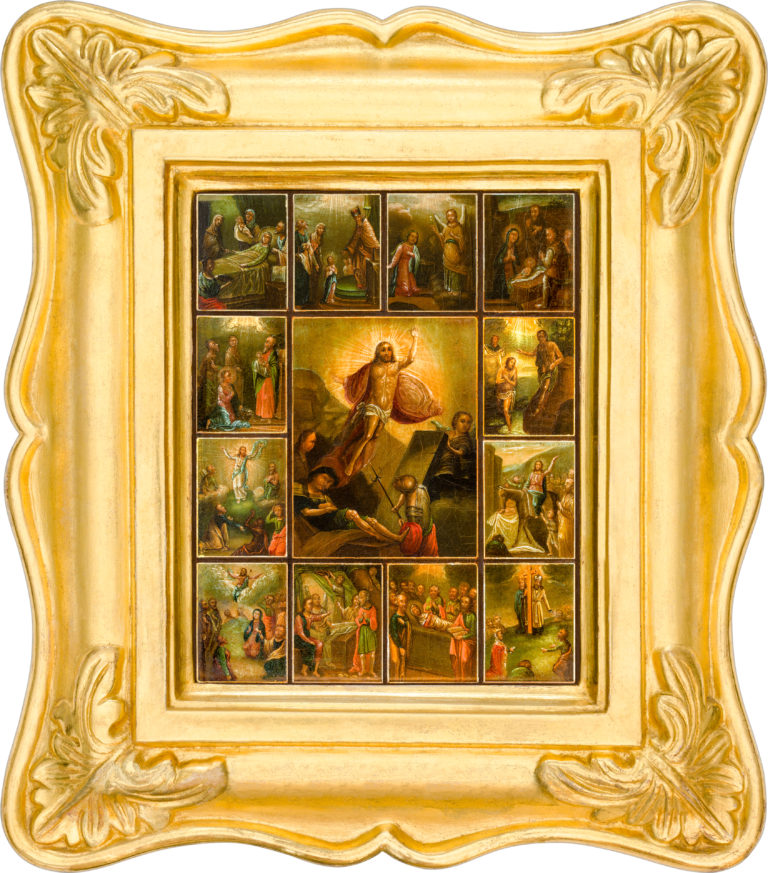The Resurrection of Christ, with Church Feasts in 12 Border Scenes
Antique Russian icon. End of the 19th – early 20th century.
Size: 14 х 11 сm – the icon; 23 х 20 cm – the frame.
Icon: wood (one whole panel), absence of the incut centerpiece, underlying layer of canvas is not visible, gesso, oil.
Frame: wood, carving, gesso, gold.
The author’s paintwork is in an overall good condition, still under the darkened layer of varnish. There is slight chafing of the paint.
Contact us

The Resurrection of Christ, with Church Feasts in 12 Border Scenes
Diagram of the border scenes:
Diagram of the border scenes:
- The Nativity of the Mother of God;
- The Entrance of the Mother of God into the Temple;
- The Annunciation;
- The Nativity of Christ;
- Candlemas (The Meeting of Christ in the Temple);
- The Theophany (The Baptism of Christ);
- The Transfiguration;
- The Entrance into Jerusalem;
- The Ascension;
- The Old Testament Trinity;
- The Dormition of the Mother of God;
- The Elevation of the Holy Cross.
Hand-painted Orthodox icons depicting the Twelve Great and Minor Feasts of the Church surrounding the Resurrection scene were immensely popular among all Russian social classes. Such religious icon paintings were created in great numbers in various iconographic workshops across Russia. In folk culture, they were seen as a sort of agricultural calendar, the cycle of which was clearly linked with the feasts of the liturgical year. The Nativity of the Mother of God (September 8th) was the day when bees had to be locked away, and onion had to be collected. The Elevation of the Holy Cross (September 14th) reminded about the coming of winter and the beginning of the harvesting period. The Feast of the Entrance of the Mother of God into the Temple (November 21st) was the day when winter came into its own, marking the beginning of the sleigh ride season. The Nativity of Christ (December 25th) was the main family feast, the celebration of which embraced several old, pre-Christian Slavonic traditions known as Svyatki. According to popular beliefs, river waters blessed at the Feast of the Theophany (January 6th) held special powers. This water was collected and used throughout the year to bless the home, farm, and livestock belonging to a family. Candlemas (February 2nd) symbolized the meeting of Winter and Spring. On that day, Russian peasants organized ritual fist-fights to help the incoming spring. Water blessed on Candlemas was also seen as especially sacred. On the Annunciation (March 25th), the peasants burned their old straw beds to prevent the return of the last year’s maladies. Crumbs of the prosphora (holy bread) received on that day were preserved and placed in the ground with the seed grain. Pussy willow branches – blessed in Russia instead of palms during the Entrance into Jerusalem Feast – were used for healing the sick.
On the Ascension, the Russians boiled eggs and made pies and pancakes that were taken to the procession across the fields by the villagers asking for a good harvest. Pentecost or the Holy Trinity Feast (the 50th day after Pascha) was the time of the rebirth of the land and forests. On that day, churches and homes were decorated with green tree branches and flowers – as the symbols of Eternal Life. On the Transfiguration (August 6th), ripe apples and fruits were brought to the church and blessed; this was followed by the blessings of the fields with holy water. The evening of the Transfiguration marked the last farewell to the Summer sun and the meeting of Autumn. The Dormition of the Mother of God (August 15th) marked the end of the harvest season when priests blessed the harvested crops in churches. This was seen as the best time for the sowing the late seeds.
The given hand-painted icon of the Resurrection belongs to the “artistic” movement in the late 19th-century Russian icon art. The religious icon’s composition clearly signifies the artist’s good acquaintance with academic painting – most notably, with the murals of the Cathedral of Christ the Savior in Moscow painted by T.A. Neff and F.A. Bronnikov in the 1860s-1870s, which heavily influenced the Eastern Orthodox iconography and style of that period. Phototype editions dedicated to the Cathedral were incredibly popular among many religious icon painters and were sent to all corners of the Empire. The border scenes of this particular piece of antique Russian icons also imitate the composition and details of either the Festive tier or the pylons of the Cathedral, yet the artist drastically simplified the original image. The copyist character of the hand-painted icon is clearly seen in a number of distortions, especially in the proportions, poses, and perspectives. The religious icon centerpiece bears the “Rising from the Tomb” version of the Resurrection, which was more popular than the traditional “Harrowing of Hades” iconography in the Imperial period. Due to the fact that Russian icon painters often used Western European samples but simplified the original, the attribution of such religious icon paintings is rather complicated. In any case, this beautiful piece of hand-painted Orthodox icons can become a real gem of any antique Russian icon collection.